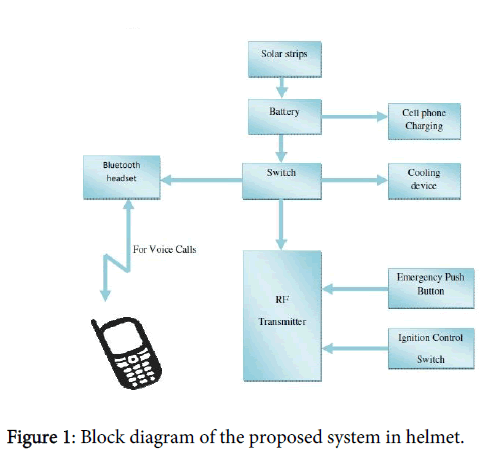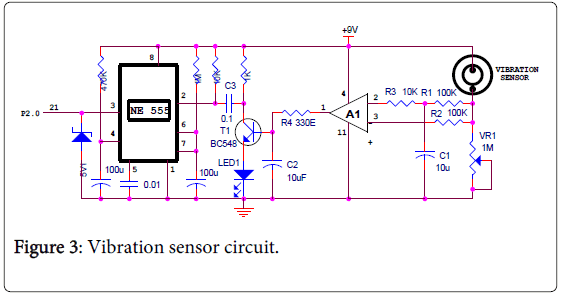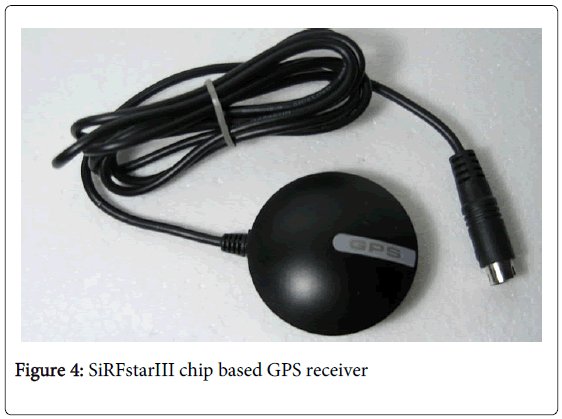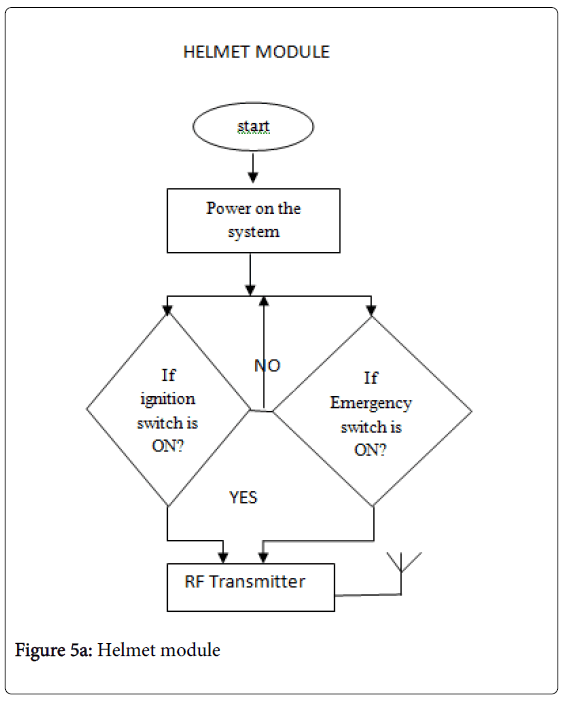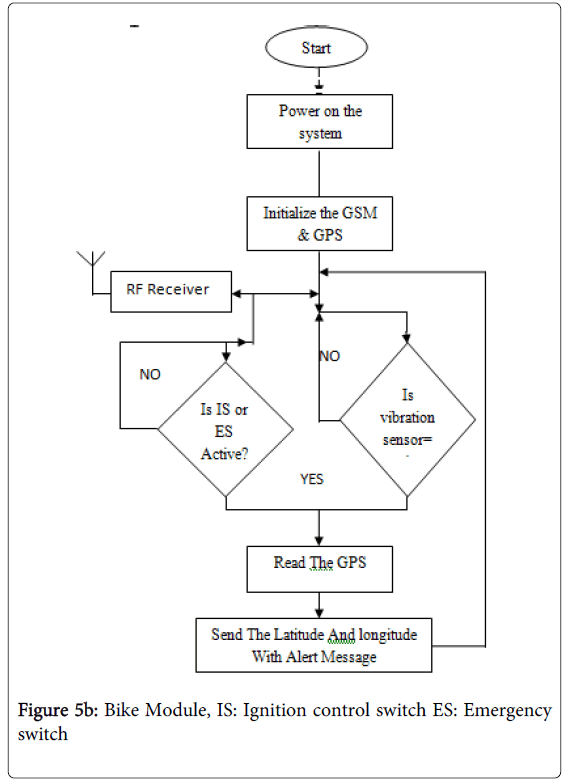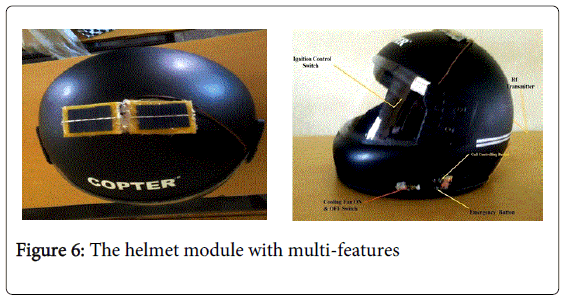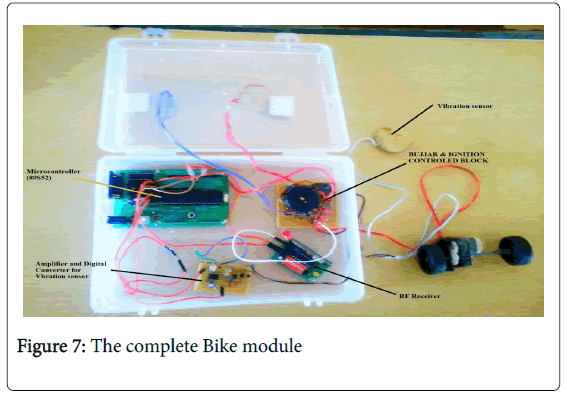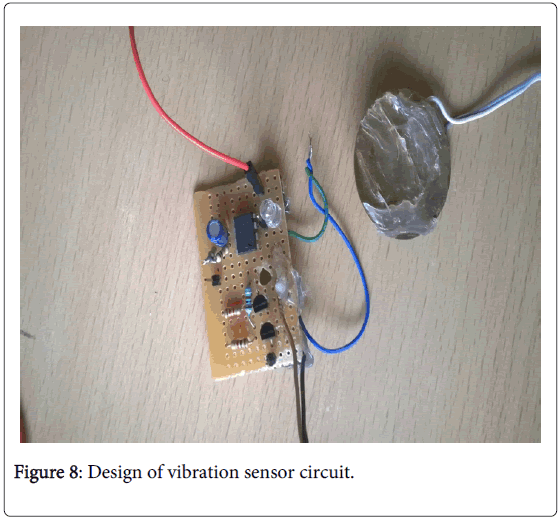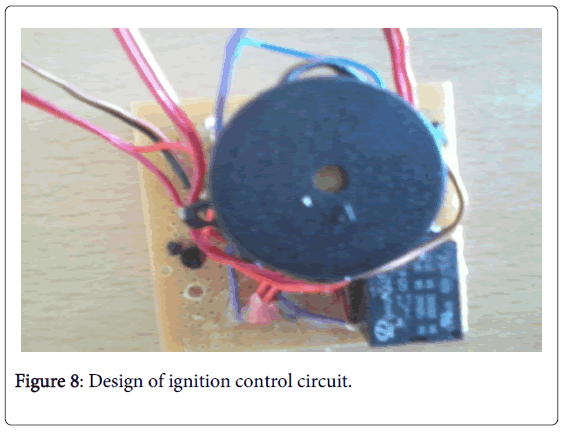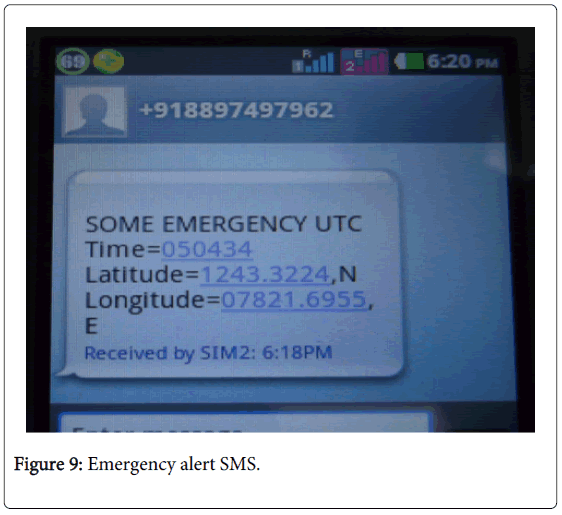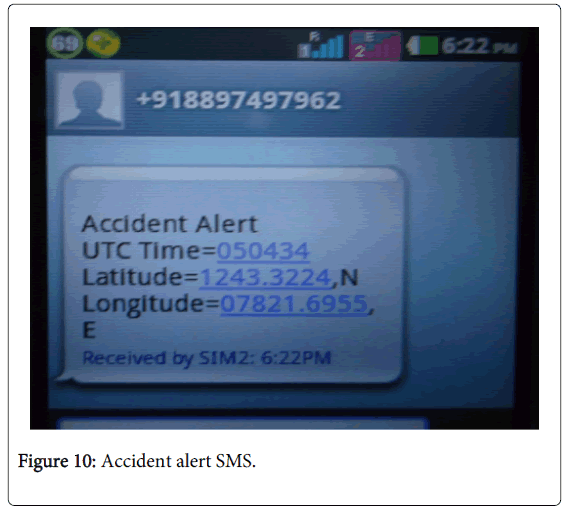Research Article Open Access
Smart Helmet: The Next Generation Solar Gadget
Kodanda Ramaiah GN1, Prabhakar V Hunagund2 and Santosh B Panjagal3*1Kuppam Engineering College, Kuppam, AP, India
2Deptartment of PG Studies and Research in Applied Electronics Jnana Ganga, Gulbarga University, KA, India
- *Corresponding Author:
- Santosh B Panjagal
Kuppam Engineering College
Chittoor, Andhra Pradesh, India
Tel: +919901335713
E-mail: santupanjagal@gmail.com
Received date: 19 January, 2015 Accepted date: 13 July, 2015 Published date: 20 July, 2015
Citation: Kodanda RGN, Prabhakar HV, Santhosh PB (2015) Smart Helmet: The Next Generation Solar Gadget. Int J Adv Innovat Thoughts Ideas 3:159. doi:10.4172/2277-1891.1000159
Copyright: © 2015 Kodanda RGN, This is an open-access article distributed under the terms of the Creative Commons Attribution License, which permits unrestricted use, distribution, and reproduction in any medium, provided the original author and source are credited.
Visit for more related articles at International Journal of Advance Innovations, Thoughts & Ideas
Abstract
Traffic jams in India are very common and are so intense that it will take hours to travel for miles; also the average temperature inside the helmet is rather more, in such situation, the rider may feel discomfort. And more over accidents occurs by attending the calls while in driving. Even it is very difficult to find a person where he met with an accident in remote areas. To resolve these current issues we developed a helmet which gives best solution. The helmet is equipped with cooling device which will reduce the temperature by using the external power source like solar energy. Similarly, by providing the Bluetooth headset inside the helmet we can avoid the handy talking and continue the call without removing the helmet. During the course of the accident the helmet uses the services of GSM with the help of GPS and sends the message body containing the precise location of the vehicle, rescue request alert to a desired number, which helps in fast medication to the victim. In case of other emergencies, like harassment, abduction or molestation, an emergency alert system could be used to ask help form cops or family members. Here helmet makes it mandatory for the rider to wear it before starting the bike. If the rider fails to do so, the vehicle won't start. The wireless communication is established between helmet and bike modules.
Keywords
Index terms; Emergency switch; GPS; GSM Modem; Helmet with Bluetooth; Set; Ignition control; Microcontroller; RF Transceivers; Vibration sensor
Introduction
Security and safety is the most talked of topics in every aspect of our life. In present day scenario we encounter numerous cases of death due to two wheeler road accidents [1]. And it is a major issue that needs a special attention, as there is one death reported for every four minutes in India. World Health Organization (WHO) has declared that 40% of the deaths and 70% of severe injuries may be reduced by wearing the helmet [1]. Now the helmet is mandatory for every two wheeler riders, but the inconvenience or discomfort by the conventional helmet lead to avoid the helmet that caused to the death. Despite of the fact that helmets are available everywhere, people are not wearing them, the reason behind not using the helmets showed the uncomfortable temperatures generated inside it [1].
In existing system, if the person met with an accident we may not ensure the fast first aid treatment; the person may die due to late medication. By using this proposed system, it sends an automatic alert message to the authorized person or ambulance in case of an accident or any emergency situations. The alert message body contains the place and time of the consequences to speed up the first aid service to the victim. With the conventional helmets we may not be able attend the calls while in riding. A supplementary to that we have implemented a system, which allows riders to attend the call while riding the bike.
To find the solution for all difficulties mentioned above, we are proposing a system that provides the multi feature helmet (smart helmet). The smart helmet incorporates Thermo electric cooler, Bluetooth enabled headphones, and emergency switch in case of emergency situations and ignition control system; that makes the rider feel comfort, safe and receive calls any time while riding. And even it provides the theft and accident alert messages by implementing GPS and GSM into the vehicle module. Here the important feature ignition controls mechanism that controls the On/Off status of the vehicle engine. Until and unless riders wear the helmet bike engine will not turn ON, that ensures helmet is mandatory.
Hardware System Design
Helmet module
Rf trnsceiver
RF module comprises of an RF transmitter and an RF receiver. The transmitter/receiver (TX/RX) pair operates at a frequency of 434 MHz; An RF transceiver receives and transmits serial data wirelessly through RF antenna. The transmission rate is of 1 Kbps-10 Kbps. The transmitted data is received by an RF receiver operating at the same frequency as that of the transmitter [2].
The RF module is often used along with a pair of encoder/decoder. The encoder is used for encoding parallel data for transmission feed while reception is decoded by a decoder [2]. HT12E-HT12D, HT640- HT648, etc. are some commonly used encoder/decoder pair ICs.
Bike module
This radio frequency (RF) transmission system employs Amplitude Shift Keying (ASK) with transmitter/receiver (TX/RX) pair operating at 434 MHz. The transmitter module takes serial input and transmits these signals through RF. The transmitted signals are received by the receiver module placed away from the source of transmission.
RF transmitter
The 212 encoders are a series of CMOS LSIs for remote control system applications. They are capable of encoding information which consists of N address bits and 12_N data bits. Each address data input can be set to one of the two logic states. The programmed address data are transmitted together with the header bits via an RF or an infrared transmission medium upon receipt of a trigger signal. The capability to select a TE trigger on the HT12E or a DATA trigger on the HT12A further enhances the application flexibility of the 212 series of encoders. The HT12A additionally provides a 38 kHz carrier for infrared systems. The 212 series of encoders begin a 4-word transmission cycle upon receipt of a transmission enable signal [4].
RF receiver
The 212 decoders are a series of CMOS LSIs for remote control system applications [5]. They are paired with Holtek’s 212 series of encoders. For proper operation, a pair of encoder/decoder with the same number of addresses and data format should be chosen. The decoders receive serial addresses and data from a programmed 212 series of encoders that are transmitted by a carrier using an RF or an IR transmission medium. They compare the serial input data three times continuously with their local addresses. If no error or unmatched codes are found, the input data codes are decoded and then transferred to the output pins. The VT pin also goes high to indicate a valid transmission. The 212 series of decoders are capable of decoding information that consists of N bits of address and 12_N bits of data. Of this series, the HT12D is arranged to provide 8 address bits and 4 data bits, and HT12F is used to decode 12 bits of address information [5-7].
Vibration sensor
The piezo-electric property is a reversible phenomenon. When an electric excitation (voltage) is applied across the opposite faces of quartz crystal, it starts to vibrate and hence produces mechanical oscillations. When mechanical vibrations are applied to the crystal, it produces electric potential across opposite faces of the crystal. Thus a crystal can be used for the construction of vibration sensor. The frequency of oscillations depends on the physical size and the shape of the crystal. Generally, smaller dimensions of crystals produce higher frequencies and bigger crystals produce lower frequencies [3].
The mechanical vibrations are applied to a thin diaphragm. The diaphragm vibrates in accordance with the applied mechanical vibrations and applies pressure to the crystal. The crystal generates a voltage in accordance with the vibrations. These voltages are of very low amplitude. Hence these signals are fed to an op-amp amplifier. The amplified signals are fed to a monostable multivibrator for producing pulses of fixed duration. The microcontroller routinely checks the outputs of the monostable multivibrator.
When the piezo-element is disturbed, it discharges the stored charge. This alters the voltage the voltage level at the inputs and the output momentarily swings high as indicated by led. This high output is used to trigger switching transistor T1, which triggers monostable multivibrator built using NE555 IC. The circuit is as shown in Figure 3 [3].
Gps receiver
The GPS module consists of a GPS chip and a GPS built-in antenna, the latest technology, and high performance SIRF3 of GPS chip SiRFstar III. Its wave rate is set to 4800 bps. The updated data rate of 1 second is the key module, providing the entire system with real-time GPS data [4].
SiRFstar-III is a range of high sensitivity GPS microcontroller chips manufactured by SiRF Technology. GPS microcontroller chips interpret signals from GPS satellites and determine the position of the GPS receiver.
SiRFstar-III features
SiRFstar III receiver and integrated antenna from UK company Antenova. This measures just 49 × 9 × 4 mm[4].
• A 20-channel receiver, which can process the signals of all visible GPS and WAAS satellites simultaneously.
• Power consumption of 62 mW during continuous operation.
• Assisted GPS can reduce TTFF to less than one second.
• Receiver sensitivity of -159 dBm while tracking.
• SBAS (WAAS, MSAS, and EGNOS) support.
Other devices like SIM300 GSM are used for communicating with the authorized persons in case of accident and/or emergency situations. The cooling device like Thermo electric cooler is used to maintain the temperature level inside the helmet to be cool for compatible journey. And the Bluetooth headsets are used to pick up the calls while the user is riding the vehicle (two wheeler).
Software System Design
To make the entire system to meet the desired functionality, a real time embedded operating system (firmware) must be designed and flashed into to the controller.
The Helmet module contains the ignition control and emergency switch as shown in Figure 5a.
The ignition controller gets activated, when the rider wears the helmet and the emergency switch is used in case of abduction or any suspicious situations. As soon as any switch activates, then an alert signal is transmitter through the RF transmitter, to the bike module that receives and an alert message along with location shall be sent to the authorized persons.
In the bike module the Vibration sensor is used to detect the accident and the same will be conveyed to the authorized persons or ambulance via the SMS through the GSM. GPS values are used to search the exact position or place where the rider is met with an accident. The entire system initialization and working of bike module is as shown in Figure 5b.
Results and Discussions
The hardware system is designed as two modules 1. Helmet module 2. Bike Module and the complete system are described in the following sections.
Helmet Module
The total setup of the helmet module is as shown in Figure 6 Its design incorporates components like, solar strips, Bluetooth headphones, Thermoelectric cooler, Ignition control switch and RF Transmitter.
Solar strips are installed on helmet to power up all the peripherals interfaced into the helmet. When the rider wears the helmet then only the ignition control activates. An emergency switch is used in case of emergency situations to alert the family members/any authorized persons about the disastrous situations. The cooling device maintains the temperature level inside the helmet, as desired by the rider for the comfortable journey. The RF Transmitter is used to send the trigger signals about the status of switches to bike module for the controlled action.
Bike Module
The total setup of the Bike module is as shown in Figure 7. The peripherals which are built into the bike module are: GSM, GPS in order to send the emergency and accident alert message to the family and/or authorized number. Ignition control indicator board for controlling the bike ignition and vibration sensor is incorporated to detect an accident. The RF receiver receives the alert signals from the helmet module and the same are sent to the controller to take necessary actions desired by the rider.
The design of vibration sensor unit for any accident detection, and ignition controlled circuit is as shown in Figure 8a,8b and 9
The output of the vibration sensor is connected to the microcontroller to detect the accident and an alert message with the place of the accident (latitude and longitude) will be sent using the GPS and GSM.
The ignition control circuit is used to control the ignition of the vehicle engine. Therefore whenever the rider wears the helmet then only the bike engine starts. Buzzer is used to give the beep indication to the rider, to wear the helmet. The ignition controlled circuit board is as shown in Figure 9.
An emergency alert system is added to the helmet module and that triggers the controller when it gets activated and an alert message containing “SOME EMERGENCY PLZ HELP” with GPS location values are being sent to the authorized persons or family members through the GSM/GPRS mobile communications, as shown in Figure 9.
An accident alert system is implemented to the bike module, the controller processes the threshold levels of vibrations generated from the sensor. If the threshold levels exceeds it indicates the accident, so an alert message containing “ACCIDENT ALERT” with GPS location values are being sent to the authorized persons or family members through the GSM/GPRS mobile communications, as shown in Figure 10.
Conclusion and Future Scope
In this paper we have discussed about developing a “Smart Helmet: A Next Generation Solar Gadget” by incorporating many features like Bluetooth headsets, cooling mechanism, emergency alert system, cell phone charging unit and ignition control unit, that are lacked in the conventional helmets. Especially the smart helmet is designed to provide security, safety and comfort journey to the rider.
The design of smart helmet has shown the satisfactory results and works well by harvesting solar energy. An emergency and accident alert system works well to combat the worst situations.
In future the helmet can be enhanced by adding some other features like, alcohol detection and riders fatigue detection system to provide a better safety and security to the rider.
Acknowledgement
The satisfaction and euphoria that accompany the successful completion of any task would be incomplete without mentioning the names of the people who made it possible, whose constant guidance and encouragement crowns all efforts with success. We wish to express our warm and sincere thanks to Management and R&D team, Kuppam Engineering college-Kuppam,
References
- Prudhvi Raj R, Sri Krishna Kanth, BhargavAdityaBharath K, (2014) “Smart-tec Helmet” Electrical and Electronics Engineering, GITAM University,Rushikonda, isakhapatnam, India. Advance in Electronic and Electric Engineering 4: 493-498.
- Sheela Joseph, Akhil S, Narayanankutty, Amalraj PM, (2014) RF Transceiver Based Traffic Alert System for Automobiles. International Journal of Advanced Research in Electrical, Electronics and Instrumentation Engineering3: 7623-7627.
- PANJAGAL SB, LAKSHMIPATHY M, (2013) “Design and Implementation of advanced security system based on one-time password for highly secure zones”. International journal of Electronics and Communication Engineering &Technology4:291-300.
- RF Transceiver module Datasheet [Online].Available:oap.sourceforge.net/datasheets/rf.pdf,
- HT 12E Datasheet [Online]. Available: www.eleinmec.com/datasheet s/ds_holtek_ht12e.pdf
- HT12DDatasheet.www.eleinmec.com/datasheets/ds_holtek_ht12d.pdf.
- SiRFstar III GPS Receiver, http://www.sirf.com/products/gps_chip.html.
Relevant Topics
- Advance Techniques in cancer treatments
- Advanced Techniques in Rehabilitation
- Artificial Intelligence
- Blockchain Technology
- Diabetes care
- Digital Transformation
- Innovations & Tends in Pharma
- Innovations in Diagnosis & Treatment
- Innovations in Immunology
- Innovations in Neuroscience
- Innovations in ophthalmology
- Life Science and Brain research
- Machine Learning
- New inventions & Patents
- Quantum Computing
Recommended Journals
Article Tools
Article Usage
- Total views: 27933
- [From(publication date):
September-2015 - Apr 03, 2025] - Breakdown by view type
- HTML page views : 22803
- PDF downloads : 5130

